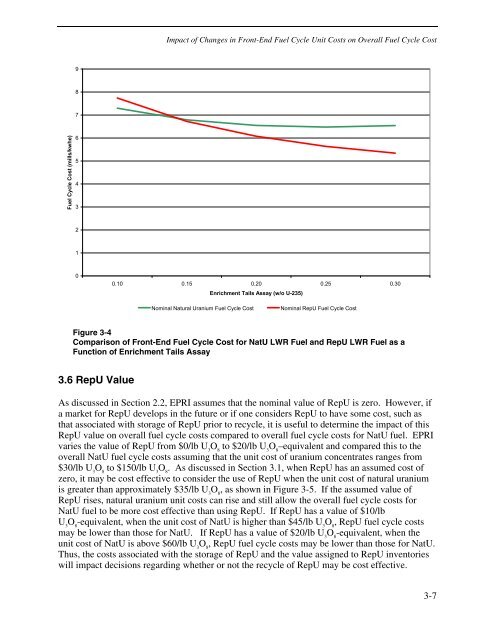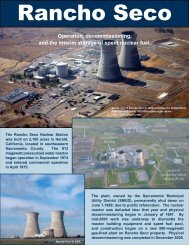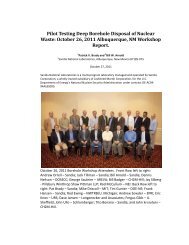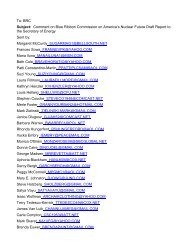Parametric Study of Front-End Nuclear Fuel Cycle Costs Using ...
Parametric Study of Front-End Nuclear Fuel Cycle Costs Using ...
Parametric Study of Front-End Nuclear Fuel Cycle Costs Using ...
You also want an ePaper? Increase the reach of your titles
YUMPU automatically turns print PDFs into web optimized ePapers that Google loves.
Impact <strong>of</strong> Changes in <strong>Front</strong>-<strong>End</strong> <strong>Fuel</strong> <strong>Cycle</strong> Unit <strong>Costs</strong> on Overall <strong>Fuel</strong> <strong>Cycle</strong> Cost<br />
9<br />
8<br />
7<br />
<strong>Fuel</strong> <strong>Cycle</strong> Cost (mills/kwhe)<br />
6<br />
5<br />
4<br />
3<br />
2<br />
1<br />
0<br />
0.10 0.15 0.20 0.25 0.30<br />
Enrichment Tails Assay (w/o U-235)<br />
Nominal Natural Uranium <strong>Fuel</strong> <strong>Cycle</strong> Cost<br />
Nominal RepU <strong>Fuel</strong> <strong>Cycle</strong> Cost<br />
Figure 3-4<br />
Comparison <strong>of</strong> <strong>Front</strong>-<strong>End</strong> <strong>Fuel</strong> <strong>Cycle</strong> Cost for NatU LWR <strong>Fuel</strong> and RepU LWR <strong>Fuel</strong> as a<br />
Function <strong>of</strong> Enrichment Tails Assay<br />
3.6 RepU Value<br />
As discussed in Section 2.2, EPRI assumes that the nominal value <strong>of</strong> RepU is zero. However, if<br />
a market for RepU develops in the future or if one considers RepU to have some cost, such as<br />
that associated with storage <strong>of</strong> RepU prior to recycle, it is useful to determine the impact <strong>of</strong> this<br />
RepU value on overall fuel cycle costs compared to overall fuel cycle costs for NatU fuel. EPRI<br />
varies the value <strong>of</strong> RepU from $0/lb U 3<br />
O 8<br />
to $20/lb U 3<br />
O 8<br />
–equivalent and compared this to the<br />
overall NatU fuel cycle costs assuming that the unit cost <strong>of</strong> uranium concentrates ranges from<br />
$30/lb U 3<br />
O 8<br />
to $150/lb U 3<br />
O 8<br />
. As discussed in Section 3.1, when RepU has an assumed cost <strong>of</strong><br />
zero, it may be cost effective to consider the use <strong>of</strong> RepU when the unit cost <strong>of</strong> natural uranium<br />
is greater than approximately $35/lb U 3<br />
O 8<br />
, as shown in Figure 3-5. If the assumed value <strong>of</strong><br />
RepU rises, natural uranium unit costs can rise and still allow the overall fuel cycle costs for<br />
NatU fuel to be more cost effective than using RepU. If RepU has a value <strong>of</strong> $10/lb<br />
U 3<br />
O 8<br />
-equivalent, when the unit cost <strong>of</strong> NatU is higher than $45/lb U 3<br />
O 8<br />
, RepU fuel cycle costs<br />
may be lower than those for NatU. If RepU has a value <strong>of</strong> $20/lb U 3<br />
O 8<br />
-equivalent, when the<br />
unit cost <strong>of</strong> NatU is above $60/lb U 3<br />
O 8<br />
, RepU fuel cycle costs may be lower than those for NatU.<br />
Thus, the costs associated with the storage <strong>of</strong> RepU and the value assigned to RepU inventories<br />
will impact decisions regarding whether or not the recycle <strong>of</strong> RepU may be cost effective.<br />
3-7



![Rainer Schottlaender[SMTP:RAINER.SCHOTTLAENDER@WEB.DE]](https://img.yumpu.com/51418350/1/190x245/rainer-schottlaendersmtprainerschottlaenderwebde.jpg?quality=85)












